A Comprehensive Life Cycle Carbon Footprint Assessment Model for Electric Power Material Warehouses
Abstract
:1. Introduction
2. Materials and Methods
2.1. Life Cycle Assessment of Electric Power Material Warehouses
2.1.1. Goal and Scope Definition
2.1.2. Life Cycle Inventory Analysis
2.1.3. Life Cycle Carbon Footprint Accounting Model
- Storage buildings and facilities
- 2.
- Loading and unloading
- 3.
- Packaging
- 4.
- Transportation
2.2. Carbon Reductions from Automated Technologies
3. Results and Discussion
3.1. Life Cycle Carbon Footprint Comparison
3.2. Carbon Reduction Pathways
3.2.1. Storage Buildings and Facilities
3.2.2. Loading and Unloading
3.2.3. Packaging
3.2.4. Transportation
3.2.5. Intelligent Management and Operation Platform
4. Conclusions
Supplementary Materials
Author Contributions
Funding
Data Availability Statement
Conflicts of Interest
Appendix A
| Warehouse Information | Automated Warehouse | Traditional Warehouse |
|---|---|---|
| Warehouse area (m2) | 13,000 | 10,703 |
| Vegetation area (m2) | 3800 | 1300 |
| Storage racks | Cut-through type | Tray type |
| Utilization rate of warehouse area | 80% | 65% |
| Utilization rate of warehouse capacity | 30% | 60% |
| Availability of intelligent management platform | Yes | No |
| Availability of LED lighting | Yes | No |
| Availability of rooftop photovoltaics | Yes | No |
| Maximum goods storage capacity (tons) | 17,160 | 10,435.425 |
| Overall goods weight in lifespan (tons) | 1,029,600 | 939,188.25 |
| Lifespan (years) | 50 | 50 |
| Warehouse Type | Automated Warehouse | Traditional Warehouse | ||
|---|---|---|---|---|
| Stage | Carbon Emission Factor (kgCO2/t) | Total Carbon Emissions (tCO2) | Carbon Emission Factor (kgCO2/t) | Total Carbon Emissions (tCO2) |
| Storage buildings and facilities | 6.196 | 7612.286 | 13.375 | 9469.448 |
| Loading and unloading | 5.848 | 7184.526 | 10.496 | 7431.250 |
| Packaging | 3.487 | 4284.245 | 4.428 | 3135.208 |
| Transportation | 12.970 | 15,933.341 | 22.734 | 16,095.577 |
| Information management platform | 3.677 | 4516.867 | 5.275 | 3734.606 |
| Total | 32.178 | 39,531.264 | 56.308 | 39,866.088 |
References
- Vais, A.A.; Mikhaylov, P.V.; Popova, V.V.; Nepovinnykh, A.G.; Nemich, V.N.; Andronova, A.A.; Mamedova, S.K. Carbon Sequestration Dynamics in Urban-Adjacent Forests: A 50-Year Analysis. Civ. Eng. J. 2023, 9, 2205–2220. [Google Scholar] [CrossRef]
- Peng, K.; Feng, K.; Chen, B.; Shan, Y.; Zhang, N.; Wang, P.; Fang, K.; Bai, Y.; Zou, X.; Wei, W.; et al. The Global Power Sector’s Low-Carbon Transition May Enhance Sustainable Development Goal Achievement. Nat. Commun. 2023, 14, 3144. [Google Scholar] [CrossRef] [PubMed]
- Hu, J.; Harmsen, R.; Crijns-Graus, W.; Worrell, E. Barriers to Investment in Utility-Scale Variable Renewable Electricity (VRE) Generation Projects. Renew. Energy 2018, 121, 730–744. [Google Scholar] [CrossRef]
- Pehl, M.; Arvesen, A.; Humpenöder, F.; Popp, A.; Hertwich, E.G.; Luderer, G. Understanding Future Emissions from Low-Carbon Power Systems by Integration of Life cycle Assessment and Integrated Energy Modelling. Nat. Energy 2017, 2, 939–945. [Google Scholar] [CrossRef]
- AlOmar, M.K.; Hameed, M.M.; Al-Ansari, N.; Razali, S.F.M.; AlSaadi, M.A. Short-, Medium-, and Long-Term Prediction of Carbon Dioxide Emissions Using Wavelet-Enhanced Extreme Learning Machine. Civ. Eng. J. 2023, 9, 815–834. [Google Scholar] [CrossRef]
- Li, M. Research on the Electric Power Storage and Logistics Management Method Based on the Internet of Things Technology. Inf. Comput. 2023, 35, 60–62. [Google Scholar]
- Jin, X.; Yu, L. Research and Implementation of High Priority Scheduling Algorithm Based on Intelligent Storage of Power Materials. Energy Rep. 2022, 8, 398–405. [Google Scholar] [CrossRef]
- Ren, Q.; Tao, J. KPI Corporate Management and Business Intelligence Analysis on the Application of Electric Power Enterprises. In Proceedings of the 2012 International Conference on Industrial Control and Electronics Engineering, Xi’an, China, 23–25 August 2012; pp. 1466–1469. [Google Scholar]
- Gao, F.; Cheng, Y. Research on Scheduling Strategy of Intelligent Warehouse and Automatic Verification Line. In Proceedings of the 2020 5th Asia Conference on Power and Electrical Engineering (ACPEE), Chengdu, China, 4–7 June 2020; pp. 112–115. [Google Scholar]
- Shrivastava, S.; Unnikrishnan, S. Life Cycle Assessment of Oil Storage Unit in India. Int. J. Oil Gas Coal Technol. 2021, 27, 95. [Google Scholar] [CrossRef]
- Onat, N.C.; Kucukvar, M.; Tatari, O. Integrating Triple Bottom Line Input–Output Analysis into Life Cycle Sustainability Assessment Framework: The Case for US Buildings. Int. J. Life Cycle Assess. 2014, 19, 1488–1505. [Google Scholar] [CrossRef]
- Pérez, J.; Lumbreras, J.; de la Paz, D.; Rodríguez, E. Methodology to Evaluate the Environmental Impact of Urban Solid Waste Containerization System: A Case Study. J. Clean. Prod. 2017, 150, 197–213. [Google Scholar] [CrossRef]
- Zhou, J.; Li, M.; Xu, Y.; Liu, Z.; Liu, Y.; Tian, D.; Zhao, W. Research and Practice on the Realization Path of Zero-Carbon Power Material Warehouse. Build. Energy Effic. 2024, 52, 80–83+108. [Google Scholar]
- Hong, F.; Ge, C.; Xu, H.; Hu, C.; Fei, D.; Xiao, F. Research on Carbon Emission Accounting Methods in Electricity Warehouse Management Segment. Mod. Manag. 2024, 14, 152–157. [Google Scholar] [CrossRef]
- Turner, C.; Oyekan, J.; Garn, W.; Duggan, C.; Abdou, K. Industry 5.0 and the Circular Economy: Utilizing LCA with Intelligent Products. Sustainability 2022, 14, 14847. [Google Scholar] [CrossRef]
- Manea, A.; Dolci, G.; Grosso, M. Life Cycle Assessment and Cost Analysis of an Innovative Automatic System for Sorting Municipal Solid Waste: A Case Study at Milan Malpensa Airport. Waste Manag. 2024, 183, 63–73. [Google Scholar] [CrossRef] [PubMed]
- Xue, M.; Xu, Z. Application of Life Cycle Assessment on Electronic Waste Management: A Review. Environ. Manag. 2017, 59, 693–707. [Google Scholar] [CrossRef] [PubMed]
- ISO 14040; Environmental Management–Life Cycle Assessment–Principles and Framework. British Standard Institution: London, UK, 2006.
- World Resources Institute and World Business Council for Sustainable Development. The Greenhouse Gas Protocol: A Corporate Accounting and Reporting Standard; World Resources Institute: Washington, DC, USA, 2004. [Google Scholar]
- Ma, J. Order of Ministry of Transport of the People’s Republic of China. Available online: https://www.gov.cn/gongbao/2024/issue_11206/202403/content_6937896.html (accessed on 2 December 2024).
- Cabeza, L.F.; Rincón, L.; Vilariño, V.; Pérez, G.; Castell, A. Life Cycle Assessment (LCA) and Life Cycle Energy Analysis (LCEA) of Buildings and the Building Sector: A Review. Renew. Sustain. Energy Rev. 2014, 29, 394–416. [Google Scholar] [CrossRef]
- Bauer, C.; Hofer, J.; Althaus, H.-J.; Del Duce, A.; Simons, A. The Environmental Performance of Current and Future Passenger Vehicles: Life Cycle Assessment Based on a Novel Scenario Analysis Framework. Appl. Energy 2015, 157, 871–883. [Google Scholar] [CrossRef]
- GB/T 32910.3-2016; Standardization Ministry of China. Data Center—Resource Utilization—Part 3: Electric Energy Usage Effectiveness Requirements and Measuring Methods. Standards Press of China: Beijing, China, 2016.
- Zhu, Y. Notice of the Ministry of Industry and Information Technology on Issuing the Three-Year Action Plan for the Development of New Data Centres (2021–2023). Available online: https://www.gov.cn/zhengce/zhengceku/2021-07/14/content_5624964.htm (accessed on 7 October 2024).


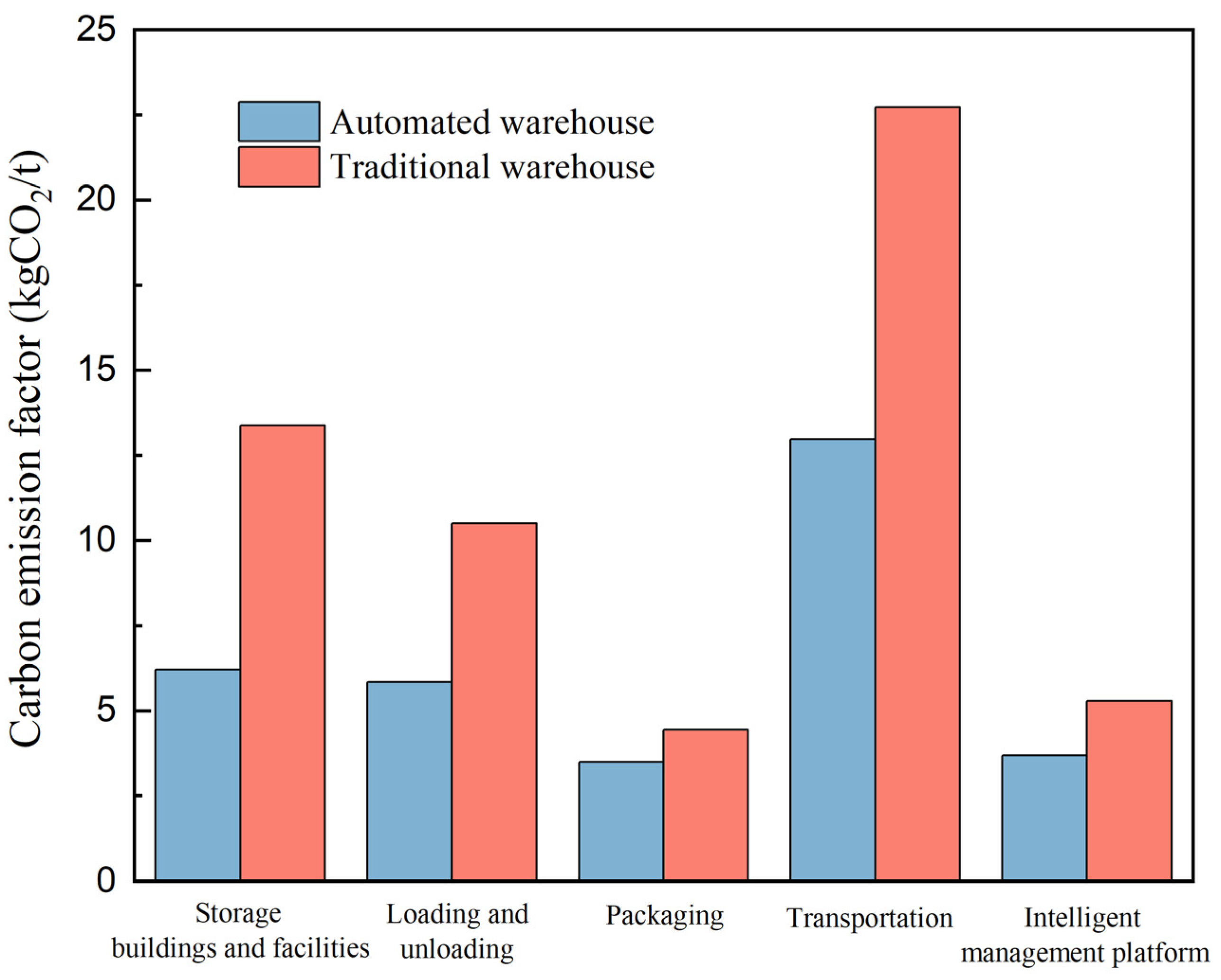
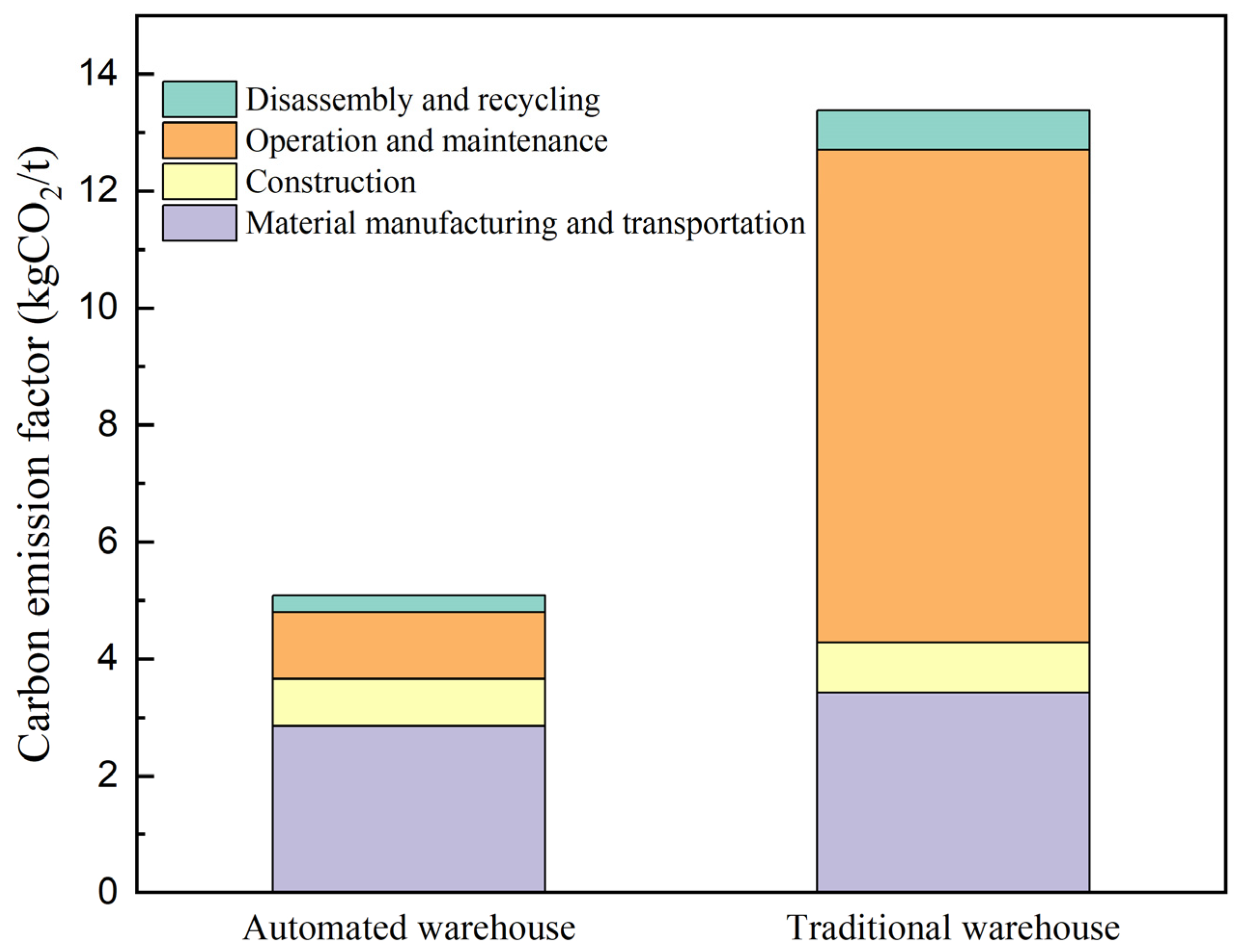

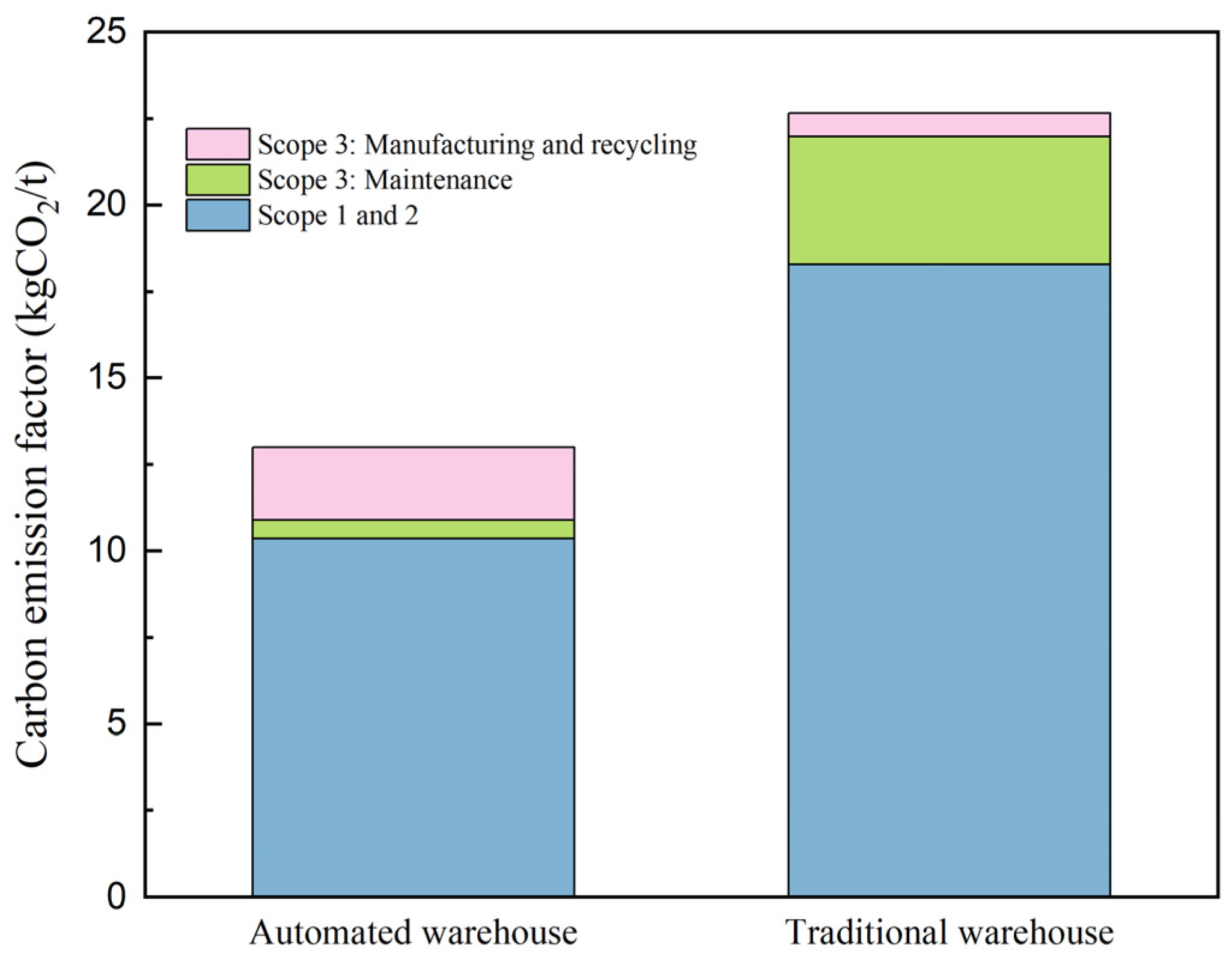
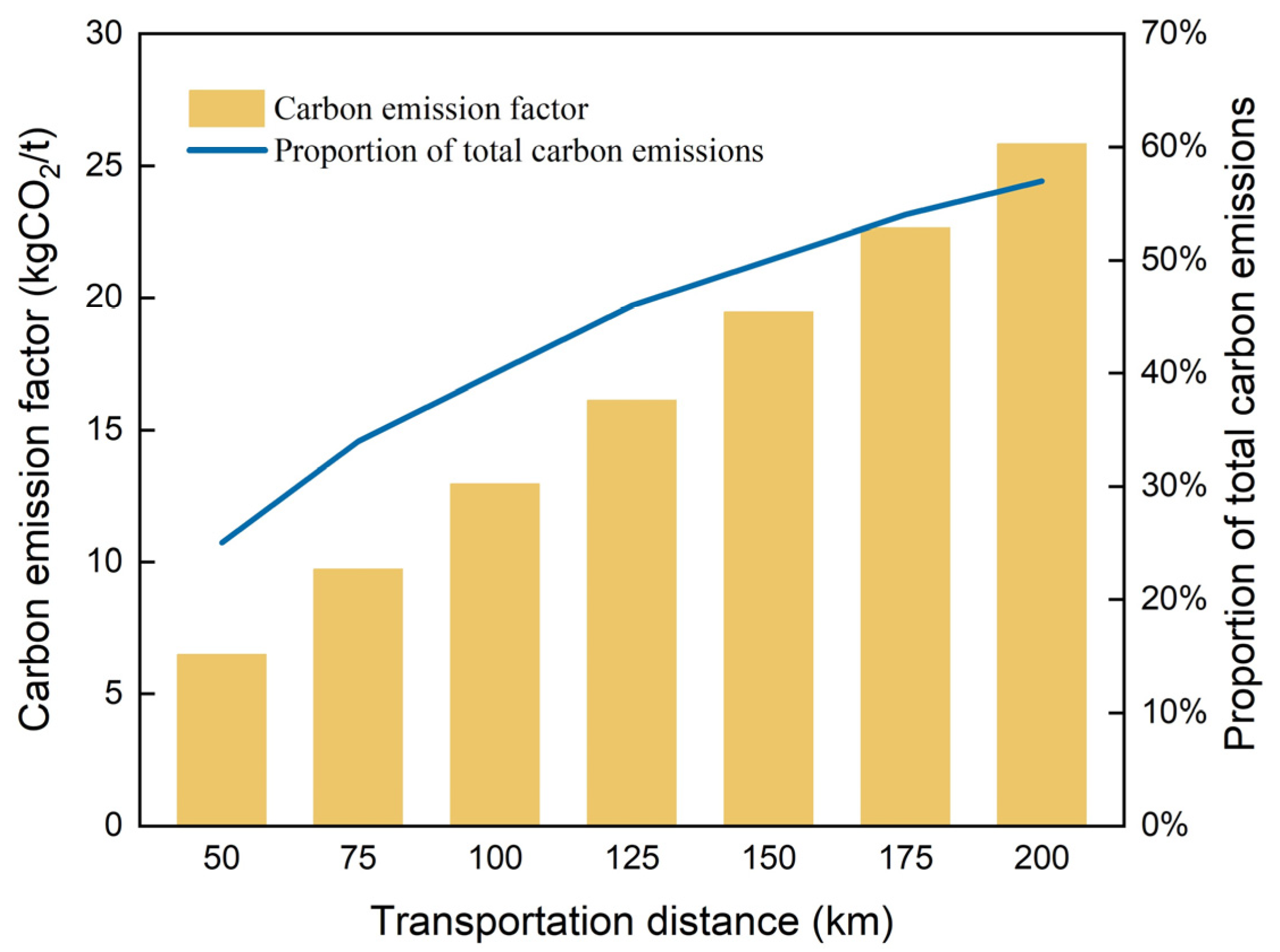
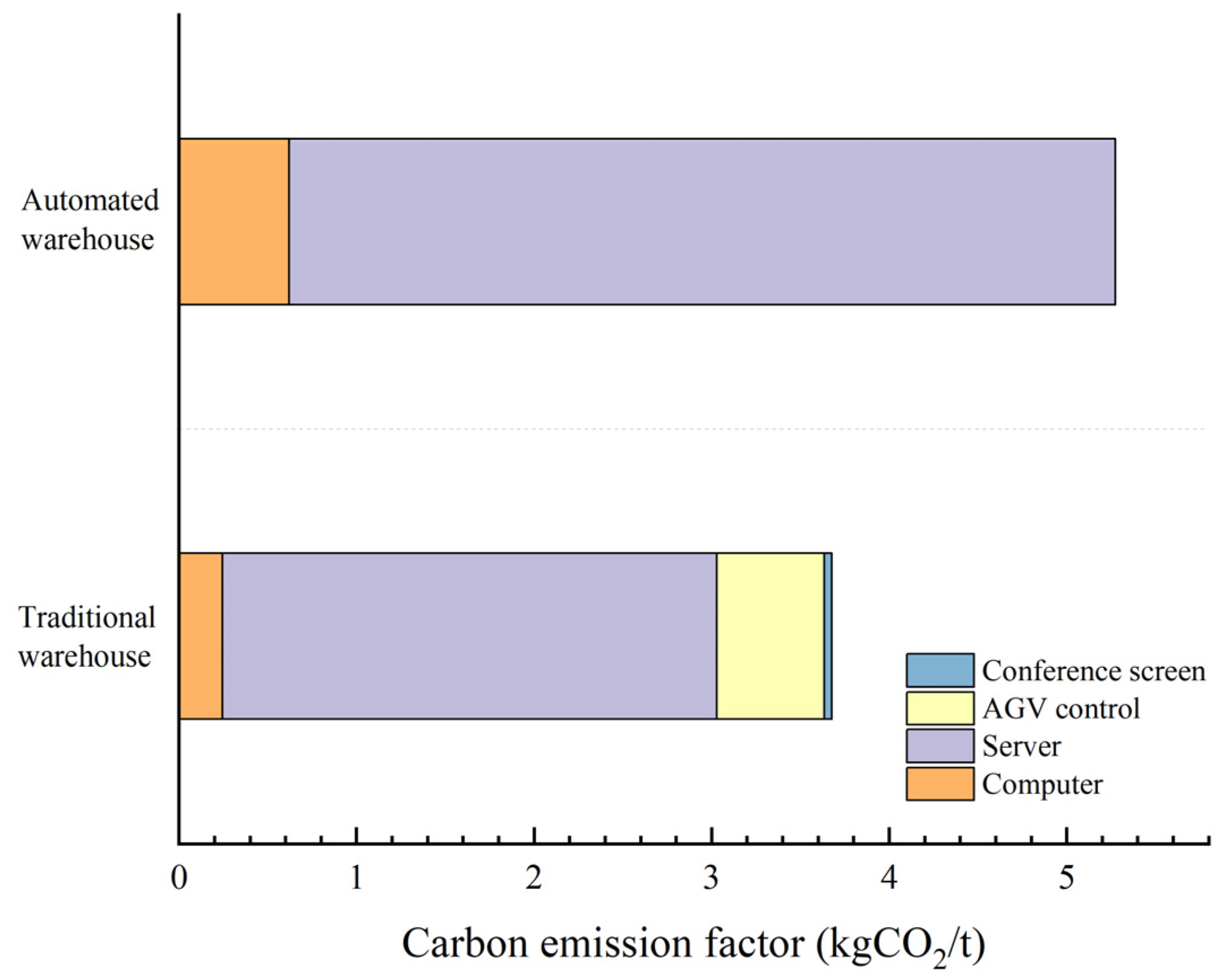
| Type | Power (kW) | Quantity | Operating Hours per Day (h) | Carbon Emissions (t) | Carbon Emission Factor (kgCO2/t) |
|---|---|---|---|---|---|
| 2t electric forklift truck | 7.6 | 2 | 5 | 794.808 | 0.647 |
| 3t electric forklift truck | 15.0 | 2 | 5 | 784.350 | 0.638 |
| 4t electric forklift truck | 16.6 | 1 | 5 | 868.014 | 0.707 |
| 3t AGV | 1.5 | 6 | 8 | 752.976 | 0.613 |
| 8t AGV | 4.0 | 1 | 8 | 334.656 | 0.272 |
| Crane | 22.4 | 1 | 5 | 1270.647 | 1.034 |
| Elevator | 3 | 5 | 1 | 156.87 | 0.128 |
| Total | \ | \ | \ | 4962.321 | 4.039 |
| Type | Power (kW) | Quantity | Operating Hours per Day (h) | Carbon Emissions (t) | Carbon Emission Factor (kgCO2/t) |
|---|---|---|---|---|---|
| 3.5t electric forklift truck | 15.0 | 1 | 5 | 784.350 | 1.108 |
| 4.5t electric forklift truck | 16.6 | 1 | 5 | 868.014 | 1.226 |
| 3t diesel forklift truck | 4.5 | 2 | 4 | 810.000 | 1.144 |
| 3.5t diesel forklift truck | 5.5 | 2 | 4 | 990.000 | 1.398 |
| 4t diesel forklift truck | 6.5 | 2 | 4 | 1170.000 | 1.653 |
| Crane | 22.4 | 1 | 5 | 1270.647 | 1.654 |
| Elevator | 3 | 5 | 1 | 156.87 | 0.222 |
| Total | \ | \ | \ | 5140.53 | 7.261 |
| Packaging Method | Proportion of Goods Weight | Material Type | Bearing Capacity (kg) | Carbon Emissions (t) | Carbon Emission Factor (kgCO2/t) |
|---|---|---|---|---|---|
| Slatted crate | 30% | plastic | 350 | 1186.951 | 1.676 |
| Corrugated box | 5% | paper | 200 | 549.745 | 0.776 |
| Tray | 30% | plastic | 1000 | 399.970 | 0.565 |
| Cable reel | 35% | wood | 4000 | 998.541 | 1.410 |
| Packaging Method | Proportion of Goods Weight | Material Type | Bearing Capacity (kg) | Carbon Emissions (t) | Carbon Emission Factor (kgCO2/t) |
|---|---|---|---|---|---|
| Slatted crate | 30% | wood | 250 | 1217.526 | 0.991 |
| Corrugated box | 5% | paper | 200 | 953.896 | 0.776 |
| Tray | 30% | wood | 1000 | 380.192 | 0.309 |
| Cable reel | 35% | wood | 4000 | 1732.630 | 1.410 |
Disclaimer/Publisher’s Note: The statements, opinions and data contained in all publications are solely those of the individual author(s) and contributor(s) and not of MDPI and/or the editor(s). MDPI and/or the editor(s) disclaim responsibility for any injury to people or property resulting from any ideas, methods, instructions or products referred to in the content. |
© 2024 by the authors. Licensee MDPI, Basel, Switzerland. This article is an open access article distributed under the terms and conditions of the Creative Commons Attribution (CC BY) license (https://creativecommons.org/licenses/by/4.0/).
Share and Cite
Luo, Y.; Tang, X.; Geng, L.; Yao, X.; Li, F.; Li, X.; Wang, Q. A Comprehensive Life Cycle Carbon Footprint Assessment Model for Electric Power Material Warehouses. Energies 2024, 17, 6352. https://doi.org/10.3390/en17246352
Luo Y, Tang X, Geng L, Yao X, Li F, Li X, Wang Q. A Comprehensive Life Cycle Carbon Footprint Assessment Model for Electric Power Material Warehouses. Energies. 2024; 17(24):6352. https://doi.org/10.3390/en17246352
Chicago/Turabian StyleLuo, Yongjun, Xinyi Tang, Lei Geng, Xiang Yao, Feihong Li, Xudong Li, and Qingrui Wang. 2024. "A Comprehensive Life Cycle Carbon Footprint Assessment Model for Electric Power Material Warehouses" Energies 17, no. 24: 6352. https://doi.org/10.3390/en17246352
APA StyleLuo, Y., Tang, X., Geng, L., Yao, X., Li, F., Li, X., & Wang, Q. (2024). A Comprehensive Life Cycle Carbon Footprint Assessment Model for Electric Power Material Warehouses. Energies, 17(24), 6352. https://doi.org/10.3390/en17246352





